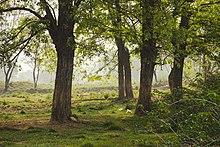
1 minute read
Irrigated Plantations
from PNGAF MAGAZINE ISSUE # 9D4D of 15th March 2022 - global timeline forest tree plantations
by rbmccarthy
Portugal SORPOCEL. E. globulus. Left roadside 4 years old. Right roadside 8 years old. CF 12 years old then two coppice rotations. Photo credit Dick McCarthy Gottstein Fellowship 1992.
Two important silvicultural practices saw their introduction during the latter part of the 19th century.
Advertisement
Use of the taungya system to plant teak (T. grandis) has already been mentioned.
The other was irrigated planting, which is generally associated with arid sites, where the annual rainfall rarely exceeds 200 mm, or semi-arid areas with a very short rainy period. Irrigated plantations are usually close to major rivers.

In the Indus basin of Pakistan, irrigation of Dalbergia sissoo
(called North Indian Rosewood, photo source
Wikipedia.) and other species has been practised for more than 140 years. The first plantings were in the Punjab in 1866 to supply firewood for a new railway and fuelwood for Lahore and other cities.
Notable irrigated plantations have subsequently been established in Iraq, Egypt, and central Sudan. Species such as eucalypts, casuarinas and poplars are commonly grown in these irrigated systems.
Eucalypts as they are fast growing, were established in plantations from the mid-1800’s to supply fuel wood for railway steam locomotion. World War 1 highlighted the deficiency in local timber supplies. Governments embarked on large scale plantations to provided fuelwood for the wood burning locomotives in Brazil, East Africa, India, and South Africa but they were inferior for sawn timber production.
Many countries planted eucalypt spp as E. saligna, E. grandis, E. urophylla, E. robusta and E. tereticornis large scale industrial plantations.








